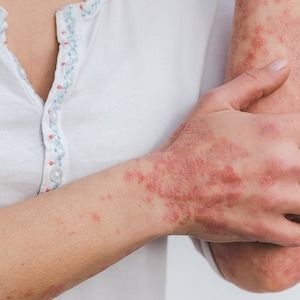Lower Limbs Found to be Hardest to Treat with Narrowband-UVB Therapy for Plaque Psoriasis
New data on using narrowband-UVB therapy for chronic plaque psoriasis found that the body’s lower limbs were the most difficult to treat, though excellent responses were still reported.

Narrowband-ultraviolet B (UVB) phototherapy for chronic plaque psoriasis patients is both safe and efficacious, according to recent findings, although the body’s lower limbs are the most difficult-to-treat region.1
These findings were the result of a single-center analysis designed to characterize the spectrum of responses to narrowband-UVB therapy in those with this skin disorder. The investigators noted that while photochemotherapy and narrowband-UVB are both used against psoriasis, UVB is acknowledged to carry fewer risks.2
This new study into narrowband-UVB was authored by Cláudia Brazão, from the Hospital de Santa Maria's Dermatology and Venereology Department at Centro Hospitalar Universitário Lisboa Norte in Portugal.
“Though phototherapy is widely used, the literature still lacks evidence regarding the response range of plaque psoriasis, including the distinct clinical response of body segments,” Brazão and colleagues wrote.
Background and Findings
The investigators carried out a 6-month, prospective, observational study on adult participants with diagnoses of plaque psoriasis who were scheduled to begin narrowband-UVB 3 times a week at the Phototherapy Unit of the Dermatology Department of Hospital de Santa Maria, Portugal.
In the study, the participants were given NB-UVB of 311 nm 3 times a week, following the department's protocol with an initial dose of 0.1 and 0.1 J/cm2 increments at each and every session up to a maximum of 2.5 J/cm2.
The research team collected both total and body segment Psoriasis Area Severity Index (PASI) scores and Dermatology Life Quality Index (DLQI) scores at baseline, every 2 weeks, at the end of treatment and then after a single month.
Based on the PASI reduction, the investigators classified response as being excellent, good, and poor (75%–100%, 50%–75%, and <50% PASI reduction, respectively). They also sorted participants into subgroups based on age at disease onset (early: <40 years-old; late: ≥40 years-old), gender, severity of disease (PASI <10; PASI ≥10), and prior UV-therapy.
During the team’s study period, 12 participants were recruited and 2 were lost to follow-up. The remaining 10 participants received narrowband-UVB and topical treatments with beta-methasone dipropionate 0.5 mg/g and calcipotriol 0.05 mg/g foam in the period post-phototherapy. A single participant withdrew due to a negative response after session 20.
A total of 9 participants underwent 12 weeks of phototherapy, of which 55.6% were reported by the investigators to be male. The participants had a mean age of 60.1 ± 18.2 years and a mean psoriasis duration of 27.1 ± 16.4 years.
The investigators noted that the lower limbs were found to be the most severely affected body region based on body segment PASI scores evaluation. The mean baseline DLQI was 8.2 ± 2.5, indicating moderate to large impacts on the participants’ quality of life.
Overall, all participants who were treated with narrowband-UVB phototherapy had an excellent response, achieving an average PASI-90 response by week 8. The investigators found there was no substantial difference in response based on gender, age at onset, disease severity, or prior UV-therapy exposure.
Mild erythema and pruritus were reported by 4 participants, although no severe side effects were observed by the research team. The participants also experienced a substantial reduction in DLQI across all body segments, with statistically significant inferior improvement reported in the lower limbs.
At 1-month follow-up, the investigators noted that all patients remained in remission, and no major changes in disease scores were found to have been reported.
“Though this study is a single-center analysis with a small sample, our findings corroborate the safety profile and efficacy of NB-UVB therapy for psoriasis and show that lower limbs are the most severely affected and difficult-to-treat body region,” they wrote.
References
- Brazão C, Alpalhão M, Filipe P. The clinical spectrum of response to narrowband-UVB therapy in chronic plaque psoriasis: The lower limbs are the most difficult-to-treat body region. Photodermatol Photoimmunol Photomed. 2023 May 1. doi: 10.1111/phpp.12877. Epub ahead of print. PMID: 37127922.
- Richard EG, Hönigsmann H. Phototherapy, psoriasis, and the age of biologics. Photodermatol Photoimmunol Photomed. 2014;30(1):3-7.